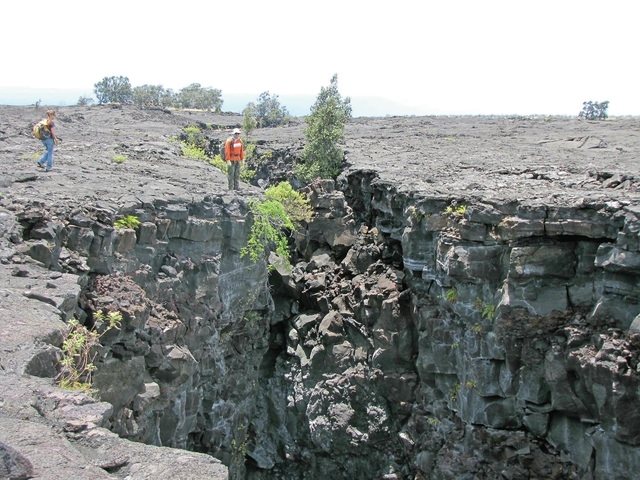In 1823, the party of English Rev. William Ellis (1794-1872), including American missionary Asa Thurston and a number of local guides, explored the wild landscape of Kilauea Volcano. Ellis returned with his ailing wife to a family home in London
In 1823, the party of English Rev. William Ellis (1794-1872), including American missionary Asa Thurston and a number of local guides, explored the wild landscape of Kilauea Volcano. Ellis returned with his ailing wife to a family home in London where, in 1824, he began writing a detailed narrative of his journey around the Hawaii Island. No other Caucasian visitors had published descriptions of this landscape, and one could say that the “history” of Ka‘u and, more broadly, of Kilauea, in the sense of contemporary written documentation, begins with Ellis.
The Ellis account (first published in 1825) is significant for several reasons. Not only is it pioneering, it also provides the first European descriptions of active, or recently active, eruptions at Kilauea. A lake — or several lakes — of molten lava spread across the floor of the summit caldera; an awesome spectacle that underscored Hawaiian cultural respect for Pelehonuamea, the volcano deity.
On the western flank of Kilauea, Ellis and company also witnessed the aftermath of a recent outpouring of highly fluid lava, which geologist Harold Stearns, 100 years later, officially designated the Keaiwa Flow (an informal name used by residents of Ka‘u at the time). The 1823 flow issued from a 6-mile-long rupture now known as the Great Crack, and poured into the ocean, destroying one small coastal village at Mahuka Bay.
Explosive eruptions occurred at Kilauea’s summit in the decades before Ellis arrived. The 1790 eruption is foremost, but at least seven others, unnoticed by Ellis, took place between then and the early 1820s. Ellis was told about the 1790 eruption but not about the later ones, evidence for which has only recently been discovered.
On the west flank (Southwest Rift Zone) of Kilauea, the general assumption made by historians is that nothing much occurred there volcanically in the decades surrounding the unusual 1823 eruption described by Ellis. This assumption, however, is questionable given what we’ve learned in recent years about unreported summit activity.
Ongoing studies have tackled the question of what may be missing from the late 18th to early to mid-19th century historical record. They use both the Footprints ash, a deposit of the 1790 eruption that fell in part of the area, and the Ellis narrative, which includes important details of how the Ka‘u landscape looked back then, to distinguish younger flows from older ones.
The geological interpretation of early accounts is daunting, but critical. We cannot reliably reconstruct the route of the Ellis party in terms of his reported travel distances, most of which are more than double what could possibly be true. But directions of travel — the party carried a compass — do seem to be reliable, allowing us to trace a partial route based on descriptions of features that have not changed much in two centuries.
Another challenge is descriptive terminology. The terms Ellis and his contemporaries used often had less clear, more poetic meanings than the scientific terms used today. Much specific terminology we now routinely use simply did not exist then, nor would it be used today by a nonscientist such as Ellis. We have to guess what Ellis meant by his sometimes colorful terms, and at times we may be wrong.
What has been learned so far is that Kilauea’s Southwest Rift Zone produced far more lava between 1790 and 1823 than Ellis alone suggests — and from fissures more widespread than only the Great Crack. We suspect this because there are many flows that are not covered by the Footprints ash. The flows instead overlie the ash, and, therefore, are younger than 1790.
Care must be taken in our analyses, however, because erosion can remove thin ash quite easily, and the ash in this area was probably thin. Nonetheless, we favor the interpretation that lava flows that lack an ash cover are indeed younger than the ash.
The Ellis narrative is a “snapshot” and not a running documentary of Kilauea during his time. In a future column, we’ll explore this surprising discovery further.
Meanwhile, the engagement of written history and geology, two ordinarily separated academic disciplines, has — once more — proven unexpectedly fruitful in our understanding of Hawaii’s natural environment.
Volcano Activity Updates
Kilauea continues to erupt at its summit and East Rift Zone. During the past week, the summit lava lake level varied between about 98-115 feet below the vent rim within Halemaumau Crater. On the East Rift Zone, the June 27 lava flow is inactive. The eastern Puu Oo breakout remained active, producing a lava flow (informally called the 61g flow) that continued to advance to the southeast. As of June 23, the flow was about 3.2 miles long. No lava flows were threatening nearby communities.
Mauna Loa is not erupting. Seismicity rates have decreased since the earthquake activity recorded in late May, but remain above background levels. Deformation related to inflation of a magma reservoir beneath the summit and upper Southwest Rift Zone continues, with inflation recently occurring mainly in the southwestern part of Mauna Loa’s magma storage complex.
No earthquakes were reported felt on the island this past week.
Vsit the HVO website (https://hvo.wr.usgs.gov) for past Volcano Watch articles, Kilauea daily eruption updates, Mauna Loa weekly updates, volcano photos, recent earthquakes info, and more; call for summary updates at 967-8862 (Kilauea) or 967-8866 (Mauna Loa); email questions to askHVO@usgs.gov.



